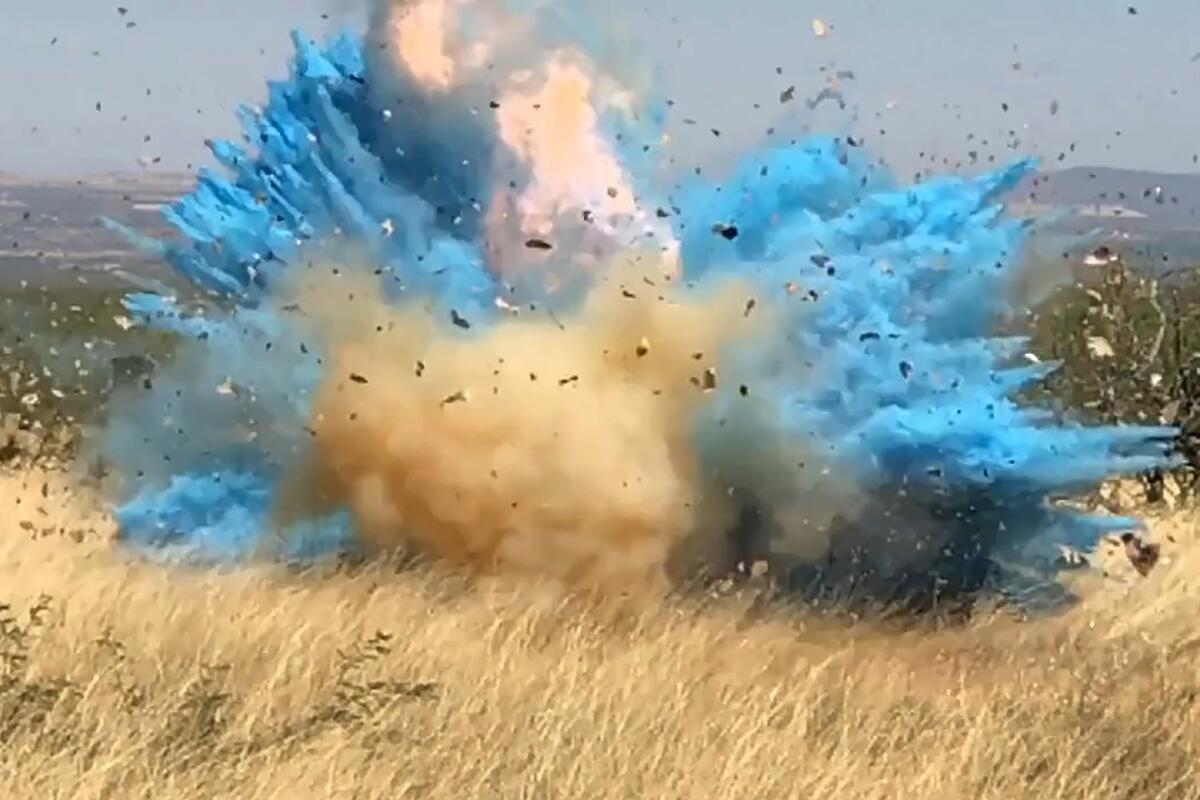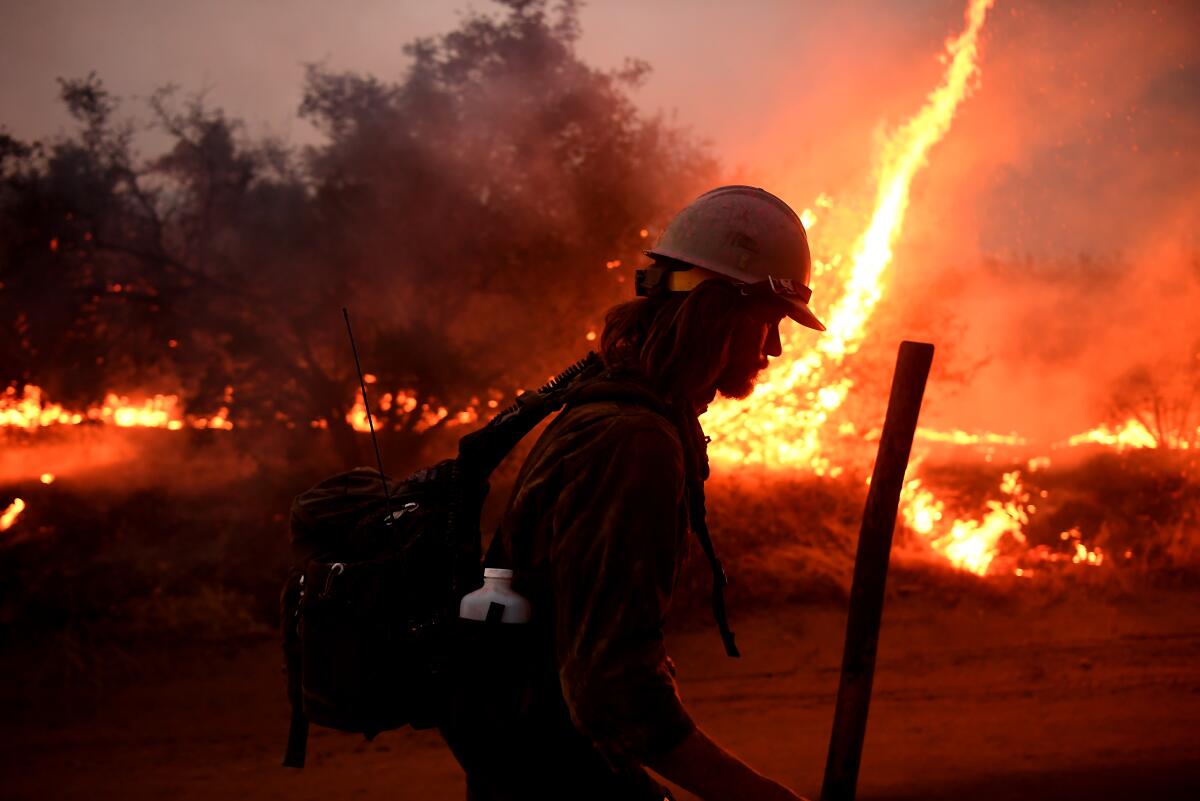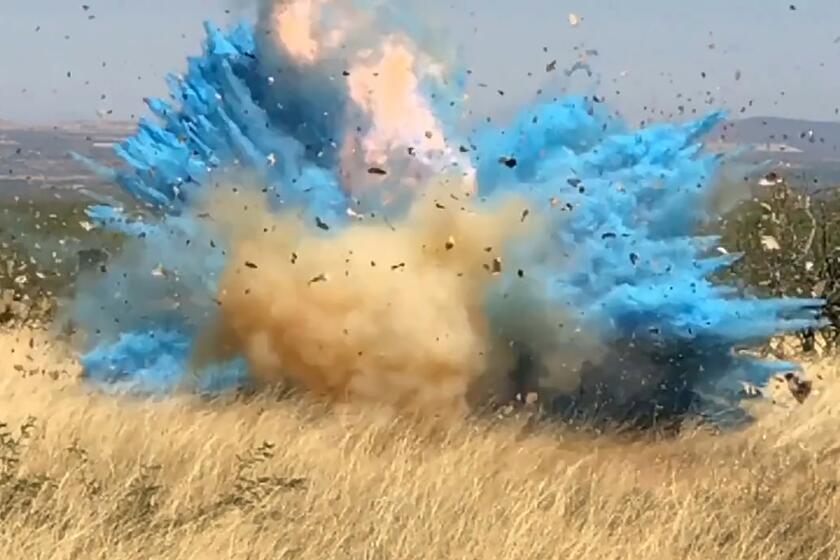‘Gender reveals’ are all the rage amid COVID-19. The latest one caused a wildfire

Pyrotechnics from a gender reveal party in Yucaipa sparked a wildfire and ignited an international firestorm of criticism and fierce cultural debate over a custom many say is toxic and dangerous — not least because the fire continues to rage.
For the record:
4:36 p.m. Sept. 11, 2020A previous version of this article misspelled the last name of the York College professor who studies gender reveals. Her name is Carly Gieseler.
“I actually had a lot of people calling me asking if it was my gender reveal,” said Samantha Nguyen of Santa Ana, who learned she was having a boy at her own gender reveal celebration the next day. “Everybody messaged me like, ‘Oh my God, what have you done?’”
The events have grown so extreme that even the Pasadena mom who originated them now regrets it. But that doesn’t mean they’re going away. Instead, gender reveals are hotter than ever, thanks in part to rapid advances in prenatal technology and a global health crisis that has compressed major rites of passage into Zoom meetings and TikTok videos.

“It’s a highly visual way to have a kind of kinship moment around the announcement of a child,” said professor Jules Gill-Peterson of the University of Pittsburgh, author of “Histories of the Transgender Child” and a critic of the celebrations. “But it’s also probably about how isolating it feels to be pregnant during this time and not to be able to rely on family.”
Indeed, the celebrations seem to have rushed in to fill a void as more traditional customs have been delayed or canceled because of the pandemic. A Muslim aqiqah, a Jewish brit milah, a Catholic baptism — all typically involve large crowds, festive meals and useful gifts. Secular baby showers, too, mainly serve to help young families amass the supplies they will need for an infant, and often rely on large guest lists.
Gender reveals are different. Their function is primarily to be witnessed — something equally possible over Instagram Live or in person. No one jumps up and down at a naming ceremony, and only babies scream at a baptism or a circumcision. But a gender reveal is designed for maximum drama, the kind that reads the same five feet away or on a 5.5-inch iPhone screen.
Gender reveal parties that were once considered private gatherings are becoming social media spectacles, sometimes with dangerous consequences.
“There’s that sense of communal ritual that we are often missing, especially during COVID,” said professor Carly Gieseler of York College, who studies gender reveals. “Maybe no one is in attendance, but you’re putting on this huge show through social media.”
The pressure to produce ever more arresting reveals is why the El Dorado fire, which erupted Sept. 5 in San Bernardino County, is the second to be sparked by a baby blue pyrotechnic. (The first burned 47,000 acres in Arizona in 2017.) But that same over-the-top visual spectacle has also made the celebration uniquely well-suited to life under quarantine, experts said.
“It’s natural that it would get a little bit crazier during the pandemic,” said Jenna Karvunidis, who held the first gender reveal in 2008, and has since renounced them as harmful. “You don’t have a special baby shower anymore, so you can spend all your money on a photographer and all these grandiose pyrotechnics.”

But it’s not just social media that has popularized the celebration, experts said. Medical technology, too, has made gender reveals both more accessible and more attractive.
Before March of this year, a healthy, low-risk mother would typically have about a dozen prenatal visits. Now, she might have half that many. That change, deemed necessary to slow the spread of the novel coronavirus, was made possible by some of the same innovations that have helped fuel gender reveal celebrations.
The last five years have seen an explosion in boutique prenatal imaging centers, nonmedical offices that specialize in assessing the sex of a fetus and producing “keepsake” ultrasound pictures. With partners barred from all medical appointments — unable to hear a fetal heartbeat or see their baby wiggle on an ultrasound — the popularity of these facilities has soared.
“More than ever, we get dads calling,” said Rebecca Karadjian of Sweet Pea 4D in Beverly Hills, one of L.A.’s many commercial ultrasound centers. “Sometimes [moms] already know the gender, and they’ll just come to show the husband and see his face.”
In a bid to reduce office visits, obstetricians have also begun using a maternal blood test to check for serious birth defects that were more commonly assessed via ultrasound. That test reveals the chromosomal sex of the fetus far sooner than it would be visible on a sonogram.
The assay is now so common that a finger-prick version is advertised to expectant parents on Instagram. SneakPeek promises that families can know the sex of their child from the time it is still technically an embryo, often before its heartbeat is detectable.
“We did the blood test at eight weeks,” said Orlando, Fla.-based photographer Sydney O’Hare, who specializes in gender reveals. “Before I was pregnant, my views [on gender reveals] were different, but after becoming pregnant and learning about all the women who don’t even make it to this point, I think it’s such a huge milestone.”
That’s because 10% to 15% of all pregnancies end in miscarriage, almost always in the first trimester. As technology has advanced, sex has gone from one of the last things parents discover about their baby to one of the first they can celebrate.
“Around seven weeks I started bleeding, and I really thought I was going to have a miscarriage,” O’Hare said. “I told my husband, I really want to know what this baby is so we can start calling a name to it. If we were to lose this baby I would regret not knowing.”
Tiffany Sevillano of North Hollywood had a similar scare: Complications in her first trimester were so bad her obstetrician offered to schedule an abortion, believing the pregnancy was unviable.
“You can’t imagine the stress and anxiety I was going through,” said the mom, who learned she was pregnant amid a COVID-19 outbreak in the skilled nursing facility where she works. “That’s why we just want to embrace every single milestone.”
The very first gender reveal party was conceived for a similar reason. Karvunidis said she’d lost other pregnancies before her first daughter was conceived, and she wanted to celebrate that this one was healthy and secure. Revealing the gender was an excuse.
“It wasn’t even really about the baby’s gender,” she said. “It was just about getting my family excited.”
She documented the event on her blog, which ended up being featured in a magazine. The magazine ended up in a lot of OB/GYN offices. The copy-cat parties ended up on Facebook.
“I didn’t see it as problematic back then — it was more [annoying] like when somebody wears your outfit,” Karvunidis said. “Then I was raising my daughters, and one of them wouldn’t play with anything unless it was pink. It seemed like that’s where it would start in the baby’s life, and after you were either a pink person or a blue person.”
Some scholars believe it’s no accident the pink and blue parties have grown more popular as trans people — and trans children in particular — have grown more accepted.
“Because trans kids are way more visible and known, that makes people want to really double down on the idea that gender is a thing in their child that belongs to them,” said Gill-Peterson, the Pittsburgh professor. “Maybe things are not like the 1950s anymore, but we still really want kids to be boys or girls.”
But she also said the parties are an easy target.
“I would love to see this cultural fad blow out and fade away,” Gill-Peterson said. “But ultimately I feel much more worried about all of the ways trans children’s lives, their ability to exist, is under constant attack right now.”
The inventor of the gender reveal said she hoped expectant families would find a way to celebrate the start of their second trimester without invoking “toxic” stereotypes about boys and girls.
“Do a pregnancy reveal — it doesn’t have to be this whole aggressive gendered thing,” Karvunidis said. “You could come out with body paint or balloons. You don’t have to light anything on fire.”
More to Read
Sign up for Essential California
The most important California stories and recommendations in your inbox every morning.
You may occasionally receive promotional content from the Los Angeles Times.












